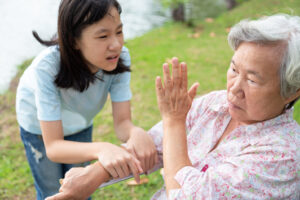Playback speed:
Behavioural and Psychological Symptoms of Dementia (BPSD) often present significant challenges, impacting both the person with dementia and those providing care. This article delves into common manifestations of BPSD and introduces the ABC approach—a structured method to analyse and manage these symptoms effectively.
Persons living with dementia may experience behavioural and psychological symptoms of dementia (BPSD) which can include symptoms of disturbed perception, thought content, mood, or behaviour. Here are some examples of BPSD that are commonly seen in persons living with dementia:
Physical Aggression Hitting/kicking/scratching/pinching others |
Verbal Aggression Insults, swearing, threats |
Self-harm Cutting/hitting and starving oneself |
Repetitive Vocalisation Shouting, screaming, crying out |
Perseveration Constantly repeating speech or action, repetitive questioning or singing. |
Wandering Aimlessly walking around the environment they are in. |
Restlessness Fidgets, unable to settle down, pacing, ‘on the go’ |
Apathy Difficult to engage, shows no interest in activities, lack of motivation |
Clinging Constant need to follow/hold on to others e.g. caregivers or staff |
Pilfering or Hoarding Possessions, rubbish, paper, food, etc. |
Lack of Self-care Hygiene problems, appears dishevelled |
| Spitting |
| Faecal Smearing |
Inappropriate urinating In public, not in toilets, etc. |
Stripping Removes clothes inappropriately, flashes private parts, etc. |
Inappropriate Sexual Behaviour Masturbates in public, makes inappropriate advances to others, etc. |
Sleep problems Sleeping too much during the day, nighttime awakening, insomnia, etc. |
Resistance to Care Deliberately ignores caregivers’ requests, refuses food, resists selfcare or help |
Suspiciousness Accusing others of stealing, fear of being harmed by others |
Depression/dysphoria Verbalises negative thoughts, suicidal thoughts, loss of interest in activities |
Elation/Euphoria Intense happiness, elevated self-confidence, etc. |
Hallucinations Visual, auditory, tactile, etc. |
Delusions Misinterpretation of perceptions or experiences |
Anxiety Excessive worrying, nervousness, or unease about something |
Paranoia Unjustified suspicion and mistrust of other people or their actions |
One of the ways to manage and reduce the occurrence of BPSD is to utilise the ABC approach.
What is the ABC approach?
The ABC approach is a simple and effective method for understanding and managing behaviour changes by analysing the triggers, actions or responses, and outcomes associated with those behaviours:
A = Antecedents
B = Behaviour
C = Consequences
It allows for the observation of events leading up to a change in behaviour, as well as the immediate and long-term effects of that behaviour.
By breaking down behavioural events into these components, caregivers can gain insights into why these behaviours occur and develop targeted strategies to support persons living with dementia to reduce the impact and frequency of BPSD.
Let’s dive deeper into each of the steps of the ABC approach.
Behaviour
“Behaviour” in the ABC Approach refers to the specific behaviour change that needs to be addressed. Those behaviours that are of immediate concern would be those that risk harm to the person living with dementia or others or have a negative impact on the quality of life of the person living with dementia and/or their caregivers. Look at one behaviour at a time in the problem-solving process.
Be as specific as possible. For example, if the person living with dementia is displaying signs of aggression, be specific to describe the presenting behaviour. Examples of specific presenting behaviours include, using the umbrella to hit the caregiver, shouting vulgarities, throwing a cup at the caregiver.
Antecedents
Antecedents are events or factors that precede the behaviour change and contribute to its occurrence. Antecedents are also called “triggers” because they “set off” behaviours. When reviewing these events, it is important to take note of the following points:
- Does the environment provide a safe place for the person living with dementia to walk around?
- Does it encourage independence, dignity and mobility?
- Does it accommodate their personal cultural and lifestyle habits?
- Other factors include:
- Noise
- Clutter
- Bright lights/glare on the floor
- Mirrors
- Temperature
- Recent changes to the environment
- Basic needs:
- Hunger, fatigue, constipation/faecal impaction
- Recent change in medical condition:
- Metabolic: Hyper/hypo thyroidism, hypercalcemia, hyponatremia
- Infection: Urinary tract infection, pneumonia, septicaemia
- Traumatic: Chronic pain, head trauma, fractures
- Systemic: Hypoglycaemia, Vitamin B12 deficiency, folate deficiency
- Medication:
- Sedatives, antihistamines, polypharmacy
- History of psychiatric illness e.g. schizophrenia
- Recent loss or accumulation of losses
- Response to delusions or hallucinations
CAUSEd is a problem-solving tool developed by Dementia Australia to enable caregivers and care professionals to identify possible triggers of behaviour changes. Find out more about CAUSEd here.
Consequences
These refer to the events that happen immediately after the behaviour occurs. It also includes all the reactions and responses to the person living with dementia, including those by the caregiver, other family members, staff or visitors.
- Ignored the person living with dementia
- Reprimanded the person living with dementia
- Tried to correct the person living with dementia
- Restrained the person living with dementia
- Sedated the person living with dementia
- Annoyed
- Upset
- Angry
- Offended
We must remember that persons living with dementia are unable to control and/or prevent these behaviours on their own. So, what we can do or respond is to change or adjust what happens before (antecedents) or after (consequences) the behaviours. And it is recommended to change one antecedent or consequence at a time so that we can evaluate what is working and what is not. It is also important to note that the condition of the person living with dementia may deteriorate with time, therefore the same strategies may not always work. Modifying the environment (physical and social) over time might be necessary.
Keeping a Behaviour Log
When dealing with behaviour changes, we can observe or reflect on the behavioural patterns of the person living with dementia during these stressful situations. One of the things that you can do is to monitor changes in behaviour with a behaviour log. By keeping a behaviour log, we may be able to find out what works to prevent or de-escalate the behaviour. Apply Person-Centred Care (PCC) to identify the unmet needs which may exacerbate the behaviour of concern, and make adjustments to the antecedents or consequence in order to address possible unmet needs related to attachment, comfort, occupation, identity and inclusion.
Here is an example of an ABC Behaviour Log that can be used to help you observe and record these behaviours efficiently:
| Table 1. Extract from Mary’s ABC chart (Sample) | |||
|---|---|---|---|
| Date & Time | A = Antecedent (Triggers) What happened immediately before the change in behaviour? | B = Behaviour What was the behaviour you would like to change? | C = Consequences (Responses) What happened after the behaviour occurred? |
| 1/7/2024, 5pm | Mary was playing mahjong with other residents and seemed very engrossed in the session. As it was dinner time, staff nurse Peter abruptly stopped the mahjong session. Mary was visibly upset and started scolding vulgarities at Peter. She said, “I was about to win and you cleared all the tiles! You are so bad!” | When her dinner plate was served to her, Mary said firmly that she did not want to eat. When the staff tried to persuade her by scooping food for her and bringing to her mouth, Mary threw her dinner plate onto the floor and continued to spew vulgarities towards the staff. | Mary tried to walk out of the dining area but was stopped by Peter. Another staff, Maryanne, came over to assist and both of them eventually brought her to her bed and gave her a radio to listen to. Mary was observed to have calmed down a little but was still visibly upset. |
| 1/7/2024, 8pm | Staff nurse Peter told Mary that it is time to go to the toilet and to change her diaper. However, Mary shouted, “No, I am not in the mood today. Do not bother me. You better get stay out of my sight!” | Mary refused to go to the toilet for her diaper change. She scolded Peter when he attempted to assist her from her bed to the toilet. | Mary kept shaking her head vigorously and tried to hit Peter multiple times. She was eventually physically restrained by two staff to the bed. Diaper change was done on the hospital bed. |
Download the ABC Behaviour Log here.
Conclusion
The ABC approach can enable caregivers to monitor behaviour changes and their associated factors over time, so that strategies can be applied to address unmet needs which may perpetuate the occurrence of behaviours of concern. Responding to behaviour changes in a Person-Centred way can help to alleviate the burden of care and improve the quality of life of the person living with dementia and their caregivers.







